Fin Garden: A Landmark of Persian Architecture
Iranian gardens are among the best examples of architecture worldwide because they combine history, architecture, and nature, and the principles of architecture have been intelligently used in all of them.
This uniqueness is so impressive that even after hundreds of years, the same architectural method is used to build new gardens and attract all eyes.
But the Fin garden in Kashan is one of the finest examples of Iranian gardens and a highly deserving representation of Iranian architectural art in gardens, listed as a UNESCO World Heritage Site.
If you're curious about this beautiful garden and want to learn more about it, follow us as we mention everything you need to know about this garden.
Fin Garden History
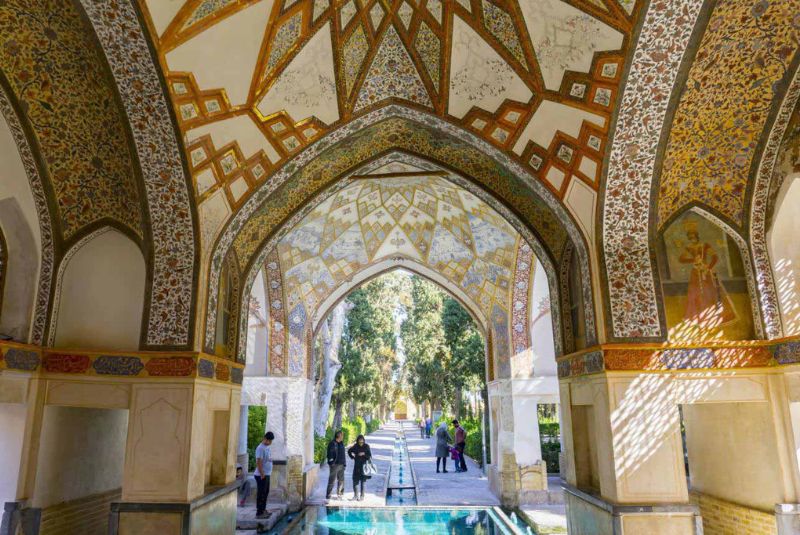
Fin Garden, located in Kashan, Iran, has a rich and diverse history that spans several centuries. While the exact origins of the garden remain unclear, it is believed to have existed since ancient times, with references dating back to the 7th century.
However, the present form of the garden was designed during the rule of Shah Abbas I in the late 16th century. By 1590, the construction was completed, making it the oldest surviving garden in Iran.
Over the years, Fin Garden underwent various developments and renovations. During the 19th century, Fath-Ali Shah Qajar greatly expanded the garden, adding new structures and enhancing its overall grandeur.
However, neglect led to partial destruction until 1935 when it was recognized as a national property of Iran. In 2012, Fin Garden achieved UNESCO World Heritage Site status, attracting both Iranians and tourists interested in Iran's history.
One notable event in Fin Garden's history is the exile and subsequent assassination of Amir Kabir, a prominent reformer, in 1952. He was held in isolation within the garden, specifically in the building known as Kashan Fin Bath, which remains a significant point of interest today.
Throughout its history, Fin Garden has been a place of interest for rulers and nobles due to its flowing spring. The garden has undergone numerous transformations and expansions, particularly during the Safavid and Qajar periods. Even in modern times, efforts have been made to preserve and restore the garden, with renovations carried out during the Pahlavi period and post-Islamic Revolution.
| Related: What is a Persian Garden
Reason for Naming Fin Garden
The original name of this garden was Shah Bagh, and due to its grandeur, it was given this name. However, after some time, the name of the garden changed to Fin Garden, Kashan. "Fin" refers to the hats that people wore in that area at that time, and gradually the area became known by the name of these hats. For this reason, the large garden built there was called Fin Garden, Kashan.
| Interested in visiting Kashan? Check out our Kashan tours to find the one that suits you best!
Architecture of Fin Garden

One of the reasons for the fame of Fin Garden is the use of Safavid architectural elements in this garden and its very high symmetry. In the past, this garden was known as one of the most symmetrical gardens in Iran and was famous for this reason.
However, after the Safavid period, with the numerous demolitions and reconstructions that took place, this symmetry was almost lost. According to official sources, the beautiful design seen in this area today was done by Ghias al-Din Jamshid Kashani. But many sources and individuals believe that the design of this garden was the work of Sheikh Bahai.
One very important element that has multiplied the beauty of this garden and given it life is the presence of water and fountains in the garden. The fountains used in this garden have cooled the garden air and added a lot of beauty to it. Ceramic pipes were used to build these fountains.
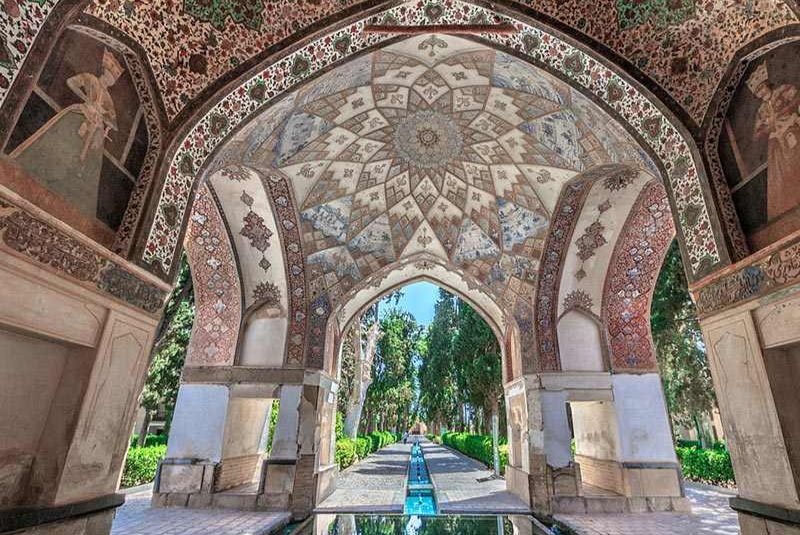
These pipes are connected to the reservoirs on one side and completely closed on the other. When water flows in the pipes, it reaches the closed end and then bursts out through openings on the pipe due to pressure. This action creates fountains in the garden's pools.
| Discover: Iranian Modern Architecture
Trees of Fin Garden
In addition to water, another important element that has given Fin Garden unparalleled beauty and remarkable freshness is the trees in the garden. Among the 580 trees in this garden, many cypresses, plane trees, and several pine trees can be seen. These trees have a very long history and have grown to such an extent that they cast a very large shadow over the entire garden.
Fin Garden Ponds
Boiling Pond
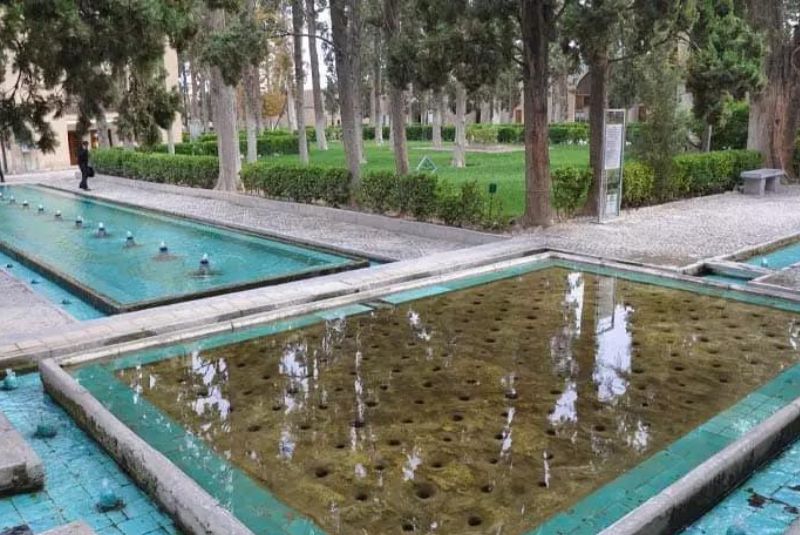
The most famous and important pond in Fin Garden, Kashan, is the boiling pond. This pond has become famous for various reasons, one of which is the beautiful tiling of the pond floor.
Golden-famed tiles decorated with gold were seen on the floor of this pond, which were made by the Abi Tahir family of tile makers and artists. Unfortunately, it was during the reign of Reza Shah that this pond was seized, and its tiles were stolen. After that, no one succeeded in replacing those tiles.
Another reason for the popularity of the boiling pond is its functionality. There were a total of 160 holes in this pond that performed the task of suction and water discharge. Some of these holes ejected water under pressure and created a fountain. Then the excess water came out of the next hole, preventing the pond from overflowing.
| If you're planning to visit Kashan, you shouldn't miss Kashan's Top 11 Historical Houses.
Twelve-Fountain Pond

Another famous pond seen in Fin Garden, Kashan, is the Twelve-fountain pond. This pond functions with a ceramic pipe system and can vertically release water from the holes without any external force and then create a beautiful water display.
Camel Throat Pond
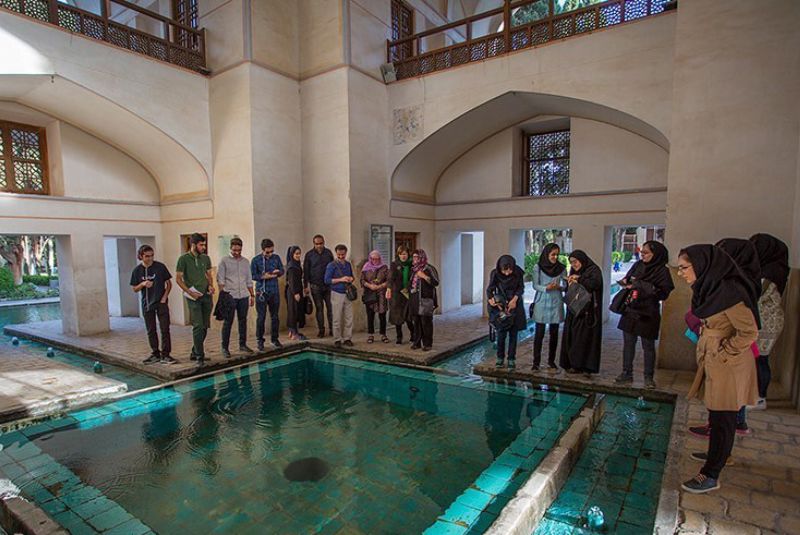
Another important pond in this garden is the camel throat pond, which has an S-shaped structure. Extraordinary architecture has also been used to build the fountain. The camel throat pond is one of the famous ponds where people say if they throw a coin into it, their wish will come true.
| Suggestion: Abyaneh Village - A Must-Visit Destination in Kashan
Different Sections of Fin Garden
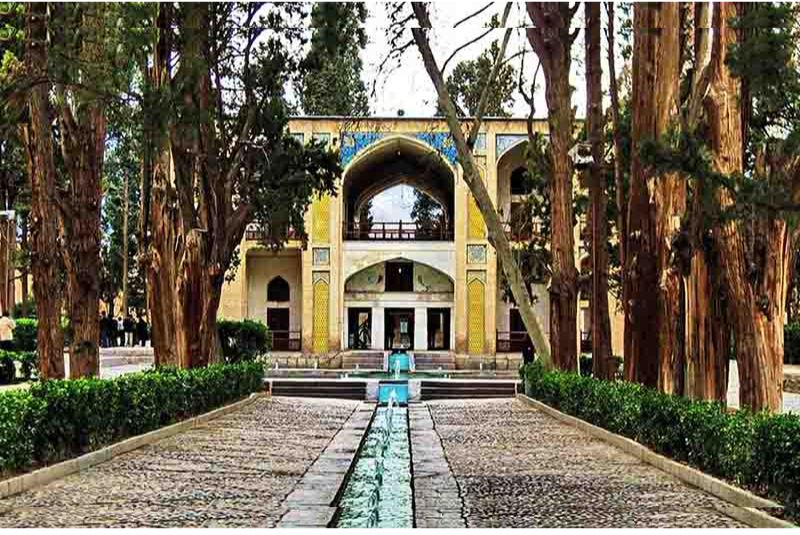
Fin Garden consists of various sections and structures, each with its own unique characteristics and significance. Over the years, additional buildings have been added, contributing to the garden's grandeur and historical value. Here are some of the most notable sections within Fin Garden.
Safavid Pavilion
Constructed during the reign of Shah Abbas I, the Safavid Pavilion served as a center for celebrations, receptions, and leisure activities. The pavilion features a quadrangular design with a stunning central pool. Paintings by Reza Mosafer Kashani adorn the entrance, although some were damaged during the Afghan invasion and earthquakes. Water flows on both sides of the mansion, leading to the large pool and twelve fountain pond.
| Read more: Sultan Amir Ahmad Bathhouse - A Glimpse of Kashan's History
Sardar Mansion
The Sardar Mansion, a two-story building at the garden's entrance, was built during the Safavid era. It contains a spacious hall, octagonal waiting area, entrance hall, and side rooms. The mansion offers panoramic views of the garden from its ivans.
Reception Room
Commissioned by Mohammad Shah Qajar, the Reception Room features five arched doors and exquisite colored glass windows. The windows include nail heads to protect the wood from termite damage. Channels embedded in the rafters promote air circulation to preserve the ceiling paintings.
Qajar Pavilion
Also known as Fath-Ali Shahi Kiosk, the Qajar Pavilion was built by Fath-Ali Shah. It comprises four pavilions, a pool room, a covered four-iwan chamber, and reception areas. The pavilion's ceiling paintings by Sani al-Molk Ghaffari depict royal banquets, hunting scenes, Quranic stories, and events related to the garden.
Fath-Ali Shahi Kiosk - Shotor Gulu of Fath-Ali Shahi
Adjacent to the Qajar Pavilion is the tea house, which divides the incoming water into three sections, supplying water for fountains and streams. Ceramic pipes direct water from Solomon's Spring, reducing the water's speed and creating a uniform flow.
| Also read: Negarestan Garden's Historic Charm
Bathhouses of Fin Garden
The garden houses two bathhouses, known as Fin Baths. The Royal Bathhouse, built for the leisure of Qajar kings, features changing rooms, steam rooms, pools, and a treasury. The Safavid Bathhouse, also known as the Small Bathhouse, gained historical significance due to the assassination of Amir Kabir.
Kareem Khan's Secluded Courtyard
Located in the southwestern corner of the garden, Kareem Khan's Secluded Courtyard includes interlocking rooms surrounding a small courtyard. This area was built under the order of Kareem Khan Zand.
Tower and Rampart of the Garden
The tower and rampart structure provides a fortress-like appearance to Fin Garden. Originally built during the Safavid period with four towers, additional towers were added during the Qajar era.
Solomon's Spring
Considered the source of running water in various parts of the garden, Solomon's Spring gushes out from Mount Dandaneh. While it dates back thousands of years, the belief that it is associated with King Solomon lacks supporting evidence.
| Discover: Underground City of Noushabad - The Lost Wonder
National Museum of Kashan
Situated in the northwest corner of Fin Garden, the National Museum of Kashan covers over 300 square meters. Divided into sections for anthropology, archaeology, and handicrafts, the museum displays a range of artifacts, including pottery, clothing, and inscriptions.
Stable and Library
Adjacent to the museum, the remains of a stable can be found, dating back to the same period as Kheloat Nizam al-Dawla. The library building, known as Badegeer Mansion, was added during the Qajar era and now serves as the Amir Kabir Public Library.
Fin Garden Location
Fin Garden is located at the end of Amir Kabir Street in Kashan, and it can be accessed by public transportation or private vehicles. If you'd like to stay near this garden, you can book accommodations at hotels such as Baharestan Hotel, Negarestan Hotel, Amir Kabir Hotel, and Iraniyan Hotel.
Additionally, many other attractions in Kashan, such as the National Museum of Kashan, Jameh Mosque of Kashan, Amir Kabir Museum, Borujerdi House, Kashan Traditional Bazaar, and Tabatabaei House, are located nearby, and you can also visit them.
| Suggestion: Best Restaurants in Kashan
Best Time to Visit Fin Garden
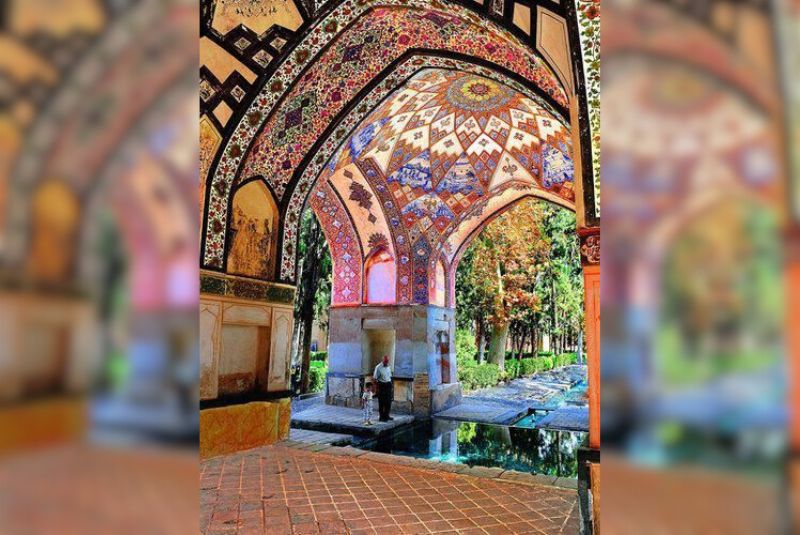
The best seasons to visit Fin Garden in Kashan are spring and summer. During these seasons, the plants and trees surrounding the garden are lush green, allowing you to enjoy its beautiful nature.
However, visiting the garden during colder seasons when it's covered in snow can also be enjoyable, especially while sipping a cup of tea in its teahouse. The garden gets very crowded during official holidays and weekends, so if you prefer to avoid crowds, we recommend visiting during weekdays.
| Plan to visit "The Fragrance Festival" in Kashan - Golabgiri Season in Iran
Fin Garden Opening Hours
First half of the year: 9:00 AM to 7:00 PM
Second half of the year: 9:00 AM to 5:00 PM
Fin Garden Entrance Fee
5,000 Iranian Rials for Iranian tourists, 50,000 Iranian Rials for foreign tourists.
Bottom Line
Fin Garden stands as a testament to Iran's rich cultural heritage and architectural prowess. With its stunning fountains, lush greenery, and historical significance, it offers visitors a serene escape into the past. From the intricate tilework of the Jushan Basin to the tranquil ambiance of the Twelve Fountains, each corner tells a story of grandeur and elegance. Fin Garden is a must-see destination for anyone exploring the wonders of Iran.
Share your story!
Comment below and let us know about your Experience.
Your story inspires others!


Comment
Leave a Comment